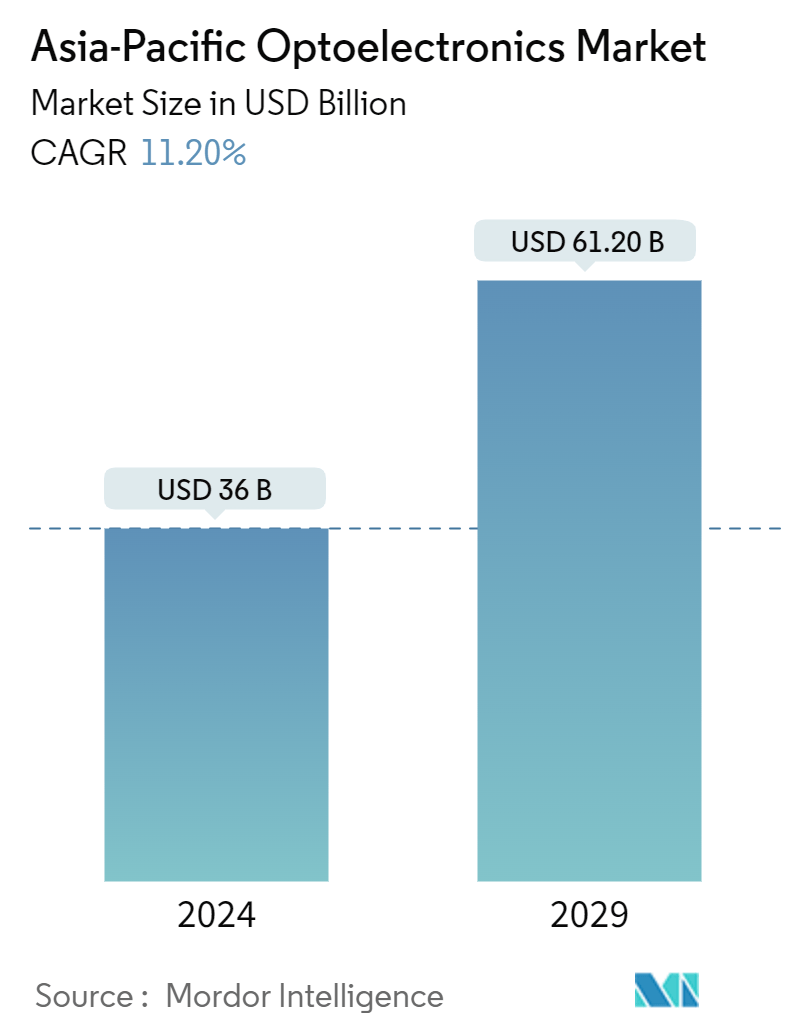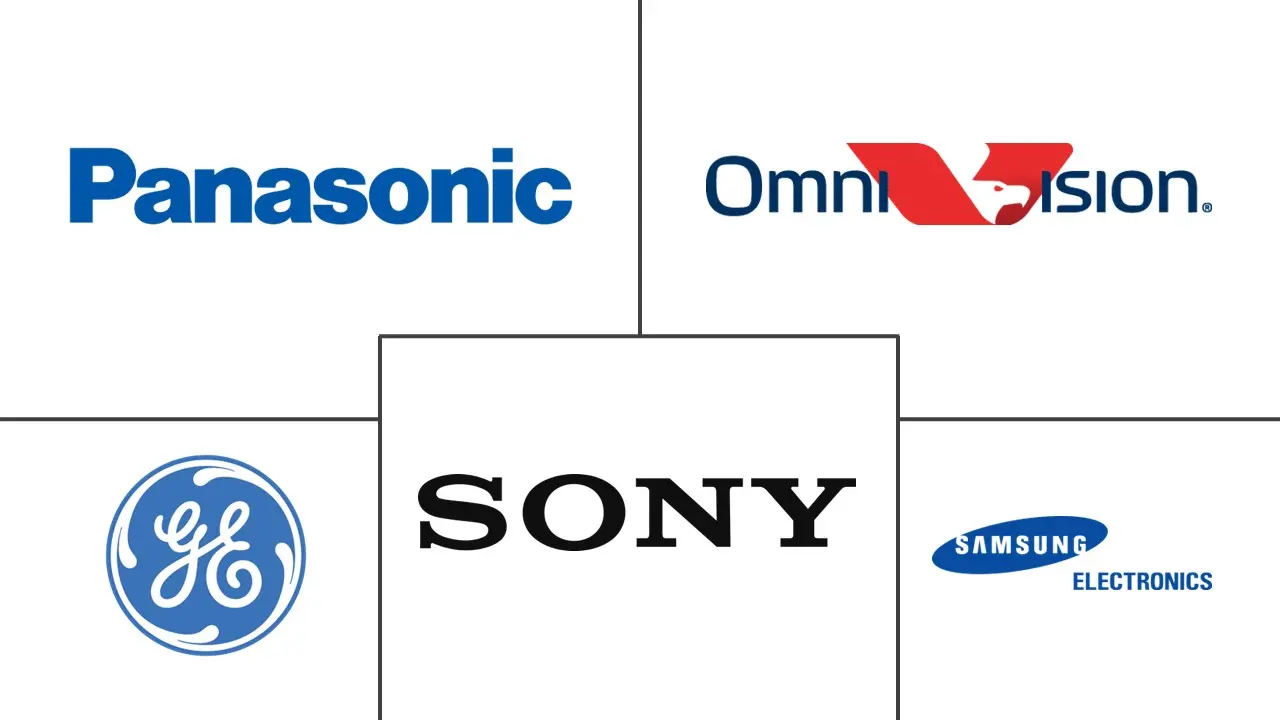Market Size of Asia-Pacific Optoelectronics Industry

| Study Period | 2019 - 2029 |
| Base Year For Estimation | 2023 |
| Market Size (2024) | USD 36 Billion |
| Market Size (2029) | USD 61.20 Billion |
| CAGR (2024 - 2029) | 11.20 % |
| Market Concentration | Medium |
Major Players
*Disclaimer: Major Players sorted in no particular order |
Asia-Pacific Optoelectronics Market Analysis
The Asia-Pacific Optoelectronics Market size is estimated at USD 36 billion in 2024, and is expected to reach USD 61.20 billion by 2029, growing at a CAGR of 11.20% during the forecast period (2024-2029).
- The increasing adoption of advanced manufacturing and technologies drives the demand for optoelectronic elements in the industrial sector using laser and machine vision systems. According to the Ministry of Science and Technology, the Indian government has set a growth target of 16% of GDP for the manufacturing sector to 25% by 2025. The National Manufacturing Policy and the emphasis on "Make in India" are effective economic development strategies.
- Optoelectronics components are semiconductor devices that can either produce light or can react to it. The demand for optoelectronics increases in the region due to increased demand for smartphones and consumer electronics. Furthermore, promotive government policies and cheaper availability of labor and resources have led to the region being the center for semiconductor production and, thus, will grow substantially fast in the coming years.
- According to the National Bureau of Statistics of China, in December 2022, the production volume of cell phones in China amounted to around 143 million units, a slight increase from the previous month. In addition, the number of cell phone subscribers in China reached about 1.66 billion in June 2022, displaying a growth momentum of a few million subscribers each month, which may further propel the studied market growth.
- Furthermore, vendors in the market are focused on investing in medical investments. In November 2022, Integrated Endoscopy launched NUVIS Single-Use Arthroscope with a 4K endoscope designed for arthroscopic surgical procedures. In addition, according to the company, 60% of the image quality is expected to increase to 4K, thus driving image sensors in the market studied.
- The expansion of semiconductor optoelectronic device manufacturing facilities is likely to boost the market in the region. For instance, in March 2023, Virtuoso Optoelectronics (VOEPL), a manufacturer and mass producer of consumer goods and electronics manufacturing services (EMS), announced the opening of its fourth manufacturing facility in Nashik, Maharashtra.
- Increasing development in the automobile industry in the country is expected to contribute to the studied market growth over the forecast period. For instance, in November 2022, Kyocera Corporation announced the introduction of an Automotive Night Vision System capable of reliably identifying collision-risk items in low-visibility operating circumstances such as rain, night, snow, fog, or smoke. The technology is designed to minimize traffic accidents and encourage safer driving.
- Furthermore, the price of optoelectronics-based goods is greater than traditional products, among the aspects limiting industry growth. Customers may prefer substitute technologies to optoelectronics-based goods, including liquid crystal displays (LCDs), over light-emitting diode (LED) displays since LCD is a more cost-effective resolution. Further, compared to typical goods, the cost of replacing spare components is more elevated.
Asia-Pacific Optoelectronics Industry Segmentation
Optoelectronics is based on the quantum mechanical results of light on electronic fabrics, especially semiconductors. Further, it is an emerging technology that incorporates the physics of rays with electricity so that one can control the other. Generally, it is in products like LED lights, solar cells, and optical fiber cables.
The studied market is segmented by component types such as LED, laser diode, image sensors, optocouplers, and photovoltaic cells among various end-user industries such as automotive, aerospace & defense, consumer electronics, information technology, healthcare, residential and commercial, and industrial in multiple countries, such as China, Japan, India, Korea, and the Rest of Asia-Pacific.
The report offers market forecasts and size in value (USD) for all the above segments.
| By Component type | |
| LED | |
| Laser Diode | |
| Image Sensors | |
| Optocouplers | |
| Photovoltaic cells | |
| Other Component Types |
| By End User Industry | |
| Automotive | |
| Aerospace & Defense | |
| Consumer Electronics | |
| Information Technology | |
| Healthcare | |
| Residential and Commercial | |
| Industrial | |
| Other End-User Industries |
| By Geography | |
| China | |
| Japan | |
| India | |
| South Korea |
Asia-Pacific Optoelectronics Market Size Summary
The Asia-Pacific optoelectronics market is poised for significant growth, driven by the increasing adoption of advanced manufacturing technologies and the rising demand for consumer electronics such as smartphones. The region's strategic focus on semiconductor production, supported by favorable government policies and cost-effective labor, positions it as a global hub for optoelectronic components. The market is further bolstered by developments in the automotive industry, where innovations like night vision systems are enhancing vehicle safety. Additionally, the healthcare sector's growing reliance on optoelectronic devices for medical imaging and diagnostics is contributing to market expansion. The integration of optoelectronic technology in medical equipment, including LEDs and laser diodes, is enhancing diagnostic capabilities and treatment options, thereby driving demand.
The competitive landscape of the Asia-Pacific optoelectronics market is characterized by the presence of major players such as Panasonic Corporation, General Electric Company, and Samsung Electronics, who leverage innovation and strategic partnerships to maintain their market positions. The market is witnessing continuous advancements, with companies investing in research and development to introduce cutting-edge products like high-resolution image sensors and laser-based equipment. The expansion of smart city initiatives and the digital transformation of urban areas in countries like China are also expected to propel market growth. Despite the higher cost of optoelectronics-based products compared to traditional alternatives, the ongoing technological advancements and increasing applications across various sectors are anticipated to drive the market's upward trajectory.
Asia-Pacific Optoelectronics Market Size - Table of Contents
-
1. MARKET INSIGHTS
-
1.1 Market Overview
-
1.2 Industry Attractiveness - Porter's Five Forces Analysis
-
1.2.1 Bargaining Power of Suppliers
-
1.2.2 Bargaining Power of Buyers
-
1.2.3 Threat of New Entrants
-
1.2.4 Threat of Substitutes
-
1.2.5 Intensity of Competitive Rivalry
-
-
1.3 Industry Value Chain Analysis
-
1.4 Assessment of Impact of COVID-19 on the Market
-
-
2. MARKET SEGMENTATION
-
2.1 By Component type
-
2.1.1 LED
-
2.1.2 Laser Diode
-
2.1.3 Image Sensors
-
2.1.4 Optocouplers
-
2.1.5 Photovoltaic cells
-
2.1.6 Other Component Types
-
-
2.2 By End User Industry
-
2.2.1 Automotive
-
2.2.2 Aerospace & Defense
-
2.2.3 Consumer Electronics
-
2.2.4 Information Technology
-
2.2.5 Healthcare
-
2.2.6 Residential and Commercial
-
2.2.7 Industrial
-
2.2.8 Other End-User Industries
-
-
2.3 By Geography
-
2.3.1 China
-
2.3.2 Japan
-
2.3.3 India
-
2.3.4 South Korea
-
-
Asia-Pacific Optoelectronics Market Size FAQs
How big is the Asia-Pacific Optoelectronics Market?
The Asia-Pacific Optoelectronics Market size is expected to reach USD 36 billion in 2024 and grow at a CAGR of 11.20% to reach USD 61.20 billion by 2029.
What is the current Asia-Pacific Optoelectronics Market size?
In 2024, the Asia-Pacific Optoelectronics Market size is expected to reach USD 36 billion.

